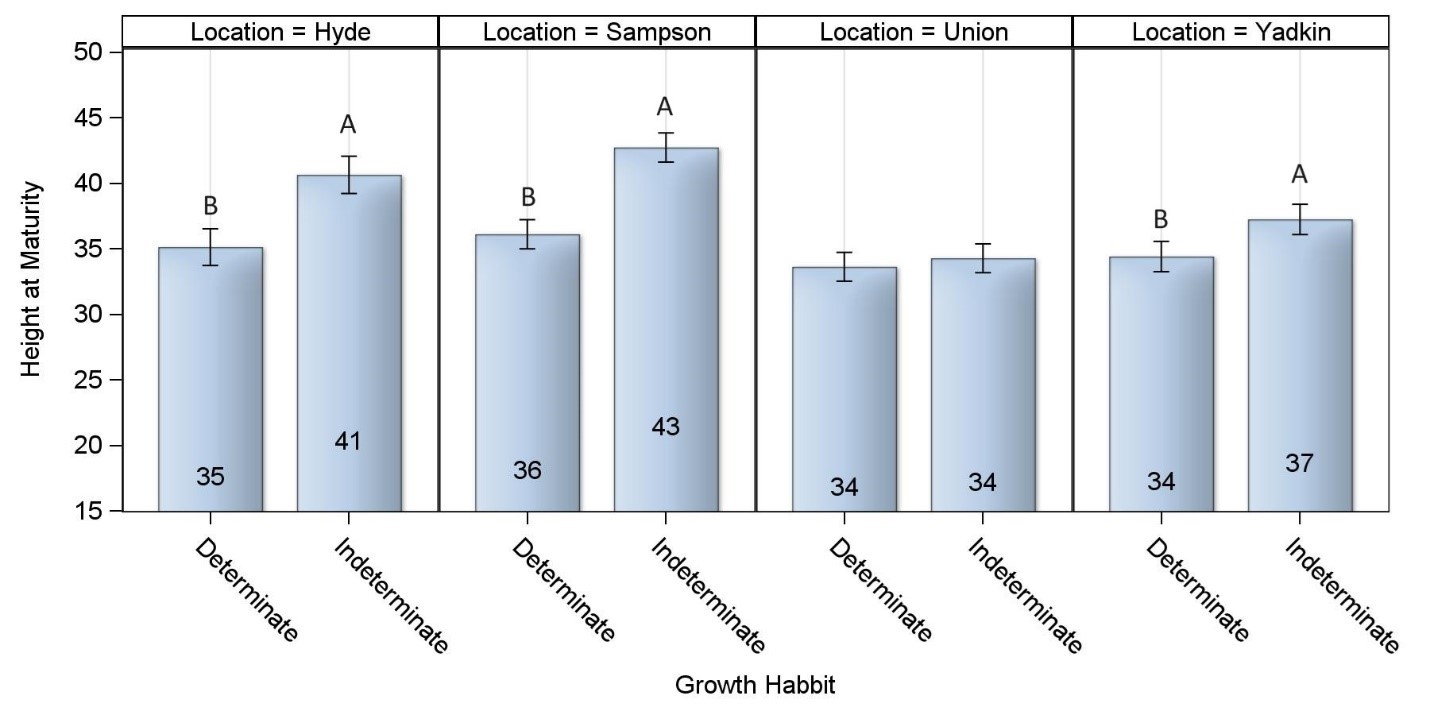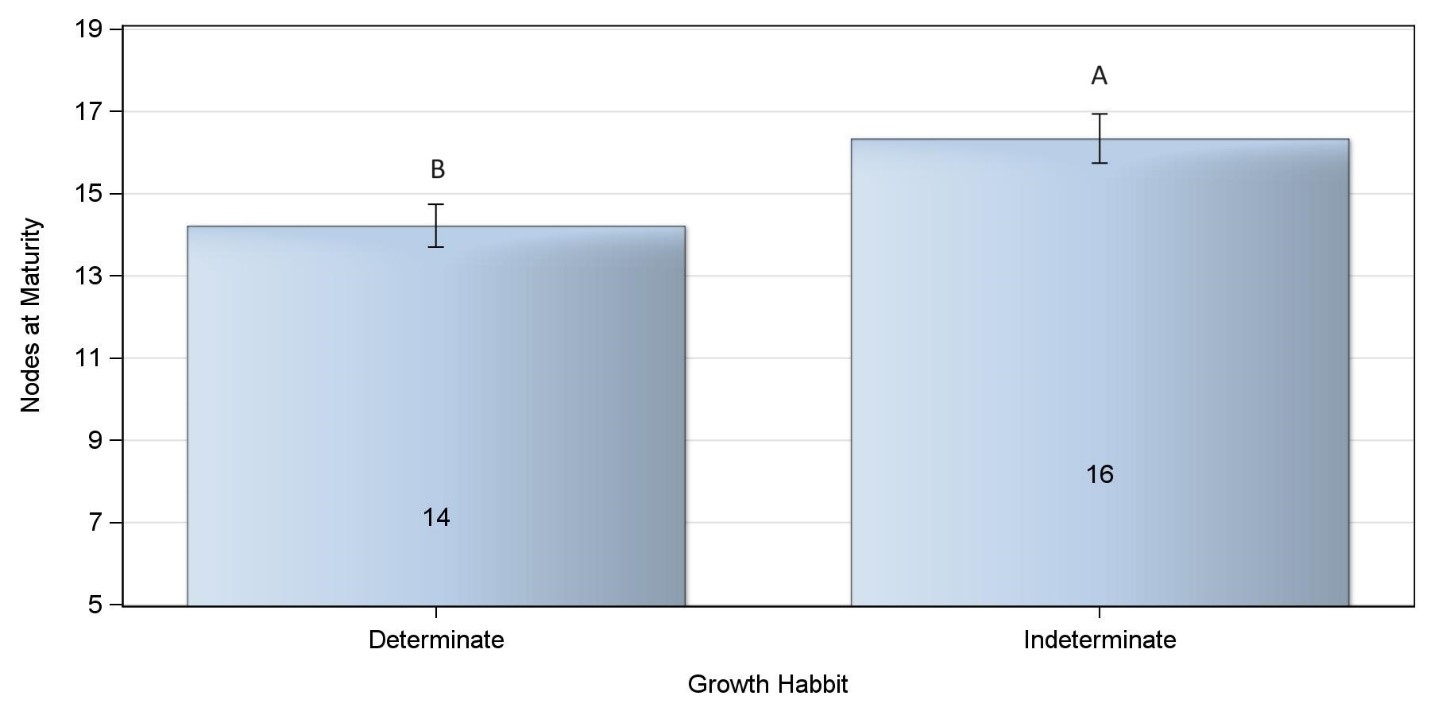Soybean Growth Habit Impact on Soybean Height, Nodes, and Yield in the Same Maturity Group
go.ncsu.edu/readext?982048
en Español / em Português
El inglés es el idioma de control de esta página. En la medida en que haya algún conflicto entre la traducción al inglés y la traducción, el inglés prevalece.
Al hacer clic en el enlace de traducción se activa un servicio de traducción gratuito para convertir la página al español. Al igual que con cualquier traducción por Internet, la conversión no es sensible al contexto y puede que no traduzca el texto en su significado original. NC State Extension no garantiza la exactitud del texto traducido. Por favor, tenga en cuenta que algunas aplicaciones y/o servicios pueden no funcionar como se espera cuando se traducen.
Português
Inglês é o idioma de controle desta página. Na medida que haja algum conflito entre o texto original em Inglês e a tradução, o Inglês prevalece.
Ao clicar no link de tradução, um serviço gratuito de tradução será ativado para converter a página para o Português. Como em qualquer tradução pela internet, a conversão não é sensivel ao contexto e pode não ocorrer a tradução para o significado orginal. O serviço de Extensão da Carolina do Norte (NC State Extension) não garante a exatidão do texto traduzido. Por favor, observe que algumas funções ou serviços podem não funcionar como esperado após a tradução.
English
English is the controlling language of this page. To the extent there is any conflict between the English text and the translation, English controls.
Clicking on the translation link activates a free translation service to convert the page to Spanish. As with any Internet translation, the conversion is not context-sensitive and may not translate the text to its original meaning. NC State Extension does not guarantee the accuracy of the translated text. Please note that some applications and/or services may not function as expected when translated.
Collapse ▲We increasingly get questions about the impact of soybean growth habit on soybean yield. Soybeans have two growth habits: Indeterminate and determinate. Indeterminate varieties will continue vegetative growth on the mainstem after the soybeans have moved into reproductive development whereas determinate varieties will cease vegetative growth on the mainstem after the plant has moved into reproductive development. Regardless of growth habit, soybeans will still flower for several weeks but generally indeterminate varieties will flower over a longer period than determinate varieties. This has driven questions about the value of the indeterminate growth habit in stressful conditions. Historically the indeterminate growth habit was only found in earlier maturing varieties (≤MG4), however now the indeterminate growth habit is available is later maturing varieties and so investigating the impact of growth habit on production within the same maturity group is needed.
Two graduate students under the direction of Dr. Dominic Reisig (Hayden Schug and Taynara Possebom) did some great work comparing soybean growth habits and investigating implications on corn earworm management. In this work comparing two pairs of varieties with different group habits, generally there were minimal differences in yield between the two soybean growth habits.
In 2023 we expanded that work to look at a broader range of MG5 varieties with the different soybean growth habits. We compared 4 MG5 varieties with the indeterminate growth habit to 4 MG5 varieties with the determinate growth habit with late April and early May planting dates.
Soybean Height: Soybean height was taller in determinate varieties at flowering than indeterminate varieties at two of the the three locations (data not shown). However, by the time that soybeans reached maturity the indeterminate varieties were taller than the determinate varieties at three of four environments (Figure 1).
Soybean Nodes: The impact of soybean growth habit on node number was consistent across environments , with 2 more nodes on average in the indeterminate than the determinate varieties at maturity (Figure 2).
Soybean Yield: The impact of soybean growth habit on soybean yield was variable across all high-yielding environments (Figure 3). In one environment (Hyde County), the indeterminate varieties out-yielded the determinate varieties. In one environment (Sampson County), the determinate varieties out-yielded the indeterminate varieties. And at two environments (Union and Yadkin Counties), there was no impact of soybean growth habit on soybean yield. This indicates the impact of growth habit on soybean yield is complex and this research will continue in full-season planting dates to further understand environmental drivers of yield response to soybean growth habit.
Soybean Green Stem: Soybean green stem incidence was higher in the indeterminate varieties than the determinate varieties across all locations (data not shown).
Soybean Lodging: Soybean lodging was higher in the indeterminate varieties than the determinate varieties at two of the four locations (data not shown).
In summary, soybean growth habit does impact soybean production in a variety of ways that are not always consistent in our environment. In 2024, this work will continue in full season planting dates and again be expanded to later season planting situations (mid-June and mid-July), as we also are getting more questions about the value of the indeterminate growth habit in a late planting situation.
*Note: This article is based on research that is led by Soybean Extension Graduate Student Lilly Bunch and funded by the NC Soybean Producers Association





